Mix-and-match kit could enable astronauts to build a menagerie of lunar exploration bots
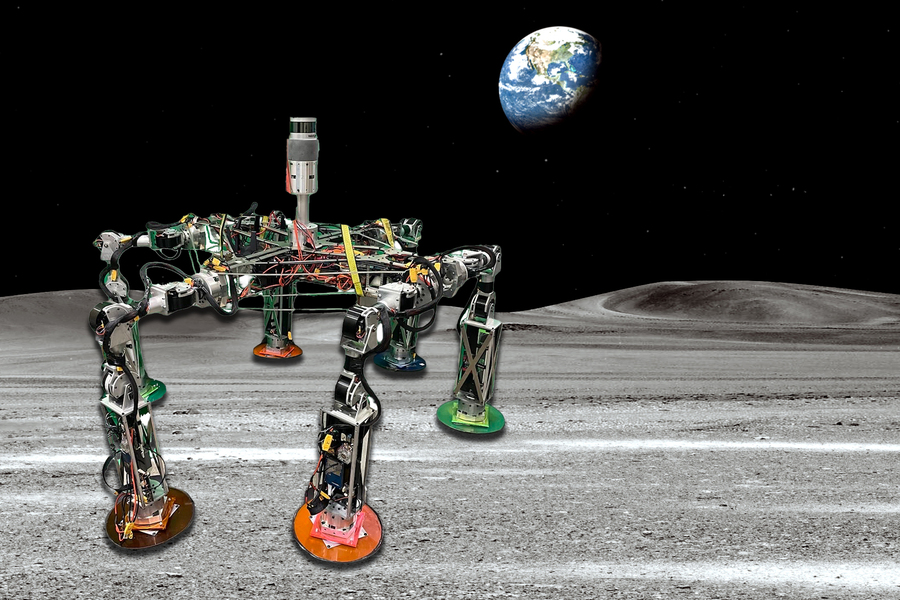
A team of MIT engineers is designing a kit of universal robotic parts that an astronaut could easily mix and match to build different robot “species” to fit various missions on the moon. Credit: hexapod image courtesy of the researchers, edited by MIT News
By Jennifer Chu | MIT News Office
When astronauts begin to build a permanent base on the moon, as NASA plans to do in the coming years, they’ll need help. Robots could potentially do the heavy lifting by laying cables, deploying solar panels, erecting communications towers, and building habitats. But if each robot is designed for a specific action or task, a moon base could become overrun by a zoo of machines, each with its own unique parts and protocols.
To avoid a bottleneck of bots, a team of MIT engineers is designing a kit of universal robotic parts that an astronaut could easily mix and match to rapidly configure different robot “species” to fit various missions on the moon. Once a mission is completed, a robot can be disassembled and its parts used to configure a new robot to meet a different task.
The team calls the system WORMS, for the Walking Oligomeric Robotic Mobility System. The system’s parts include worm-inspired robotic limbs that an astronaut can easily snap onto a base, and that work together as a walking robot. Depending on the mission, parts can be configured to build, for instance, large “pack” bots capable of carrying heavy solar panels up a hill. The same parts could be reconfigured into six-legged spider bots that can be lowered into a lava tube to drill for frozen water.
“You could imagine a shed on the moon with shelves of worms,” says team leader George Lordos, a PhD candidate and graduate instructor in MIT’s Department of Aeronautics and Astronautics (AeroAstro), in reference to the independent, articulated robots that carry their own motors, sensors, computer, and battery. “Astronauts could go into the shed, pick the worms they need, along with the right shoes, body, sensors and tools, and they could snap everything together, then disassemble it to make a new one. The design is flexible, sustainable, and cost-effective.”
Lordos’ team has built and demonstrated a six-legged WORMS robot. Last week, they presented their results at IEEE’s Aerospace Conference, where they also received the conference’s Best Paper Award.
MIT team members include Michael J. Brown, Kir Latyshev, Aileen Liao, Sharmi Shah, Cesar Meza, Brooke Bensche, Cynthia Cao, Yang Chen, Alex S. Miller, Aditya Mehrotra, Jacob Rodriguez, Anna Mokkapati, Tomas Cantu, Katherina Sapozhnikov, Jessica Rutledge, David Trumper, Sangbae Kim, Olivier de Weck, Jeffrey Hoffman, along with Aleks Siemenn, Cormac O’Neill, Diego Rivero, Fiona Lin, Hanfei Cui, Isabella Golemme, John Zhang, Jolie Bercow, Prajwal Mahesh, Stephanie Howe, and Zeyad Al Awwad, as well as Chiara Rissola of Carnegie Mellon University and Wendell Chun of the University of Denver.
Animal instincts
WORMS was conceived in 2022 as an answer to NASA’s Breakthrough, Innovative and Game-changing (BIG) Idea Challenge — an annual competition for university students to design, develop, and demonstrate a game-changing idea. In 2022, NASA challenged students to develop robotic systems that can move across extreme terrain, without the use of wheels.
A team from MIT’s Space Resources Workshop took up the challenge, aiming specifically for a lunar robot design that could navigate the extreme terrain of the moon’s South Pole — a landscape that is marked by thick, fluffy dust; steep, rocky slopes; and deep lava tubes. The environment also hosts “permanently shadowed” regions that could contain frozen water, which, if accessible, would be essential for sustaining astronauts.
As they mulled over ways to navigate the moon’s polar terrain, the students took inspiration from animals. In their initial brainstorming, they noted certain animals could conceptually be suited to certain missions: A spider could drop down and explore a lava tube, a line of elephants could carry heavy equipment while supporting each other down a steep slope, and a goat, tethered to an ox, could help lead the larger animal up the side of a hill as it transports an array of solar panels.
“As we were thinking of these animal inspirations, we realized that one of the simplest animals, the worm, makes similar movements as an arm, or a leg, or a backbone, or a tail,” says deputy team leader and AeroAstro graduate student Michael Brown. “And then the lightbulb went off: We could build all these animal-inspired robots using worm-like appendages.’”
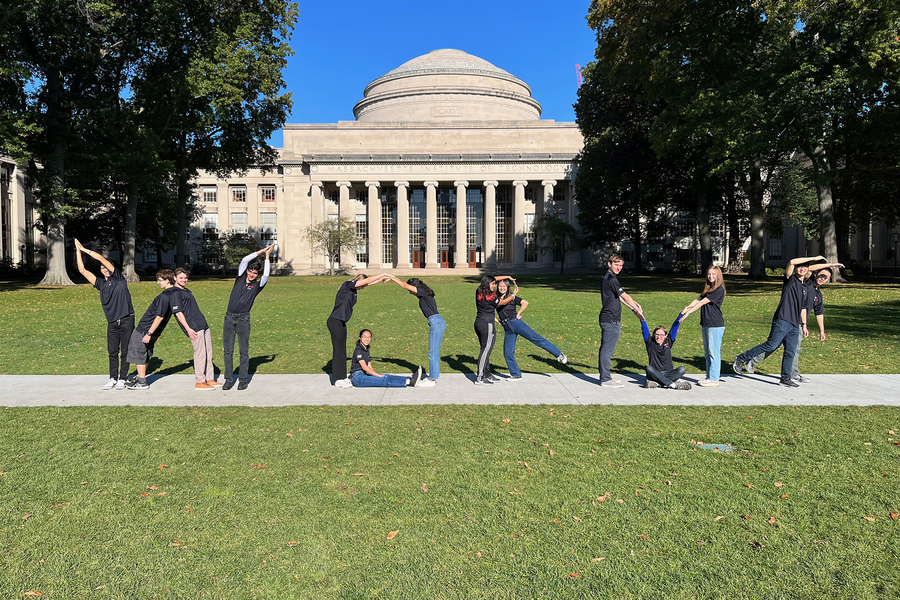
The research team in Killian Court at MIT. Credit: Courtesy of the researchers
Snap on, snap off
Lordos, who is of Greek descent, helped coin WORMS, and chose the letter “O” to stand for “oligomeric,” which in Greek signifies “a few parts.”
“Our idea was that, with just a few parts, combined in different ways, you could mix and match and get all these different robots,” says AeroAstro undergraduate Brooke Bensche.
The system’s main parts include the appendage, or worm, which can be attached to a body, or chassis, via a “universal interface block” that snaps the two parts together through a twist-and-lock mechanism. The parts can be disconnected with a small tool that releases the block’s spring-loaded pins.
Appendages and bodies can also snap into accessories such as a “shoe,” which the team engineered in the shape of a wok, and a LiDAR system that can map the surroundings to help a robot navigate.
“In future iterations we hope to add more snap-on sensors and tools, such as winches, balance sensors, and drills,” says AeroAstro undergraduate Jacob Rodriguez.
The team developed software that can be tailored to coordinate multiple appendages. As a proof of concept, the team built a six-legged robot about the size of a go-cart. In the lab, they showed that once assembled, the robot’s independent limbs worked to walk over level ground. The team also showed that they could quickly assemble and disassemble the robot in the field, on a desert site in California.
In its first generation, each WORMS appendage measures about 1 meter long and weighs about 20 pounds. In the moon’s gravity, which is about one-sixth that of Earth’s, each limb would weigh about 3 pounds, which an astronaut could easily handle to build or disassemble a robot in the field. The team has planned out the specs for a larger generation with longer and slightly heavier appendages. These bigger parts could be snapped together to build “pack” bots, capable of transporting heavy payloads.
“There are many buzz words that are used to describe effective systems for future space exploration: modular, reconfigurable, adaptable, flexible, cross-cutting, et cetera,” says Kevin Kempton, an engineer at NASA’s Langley Research Center, who served as a judge for the 2022 BIG Idea Challenge. “The MIT WORMS concept incorporates all these qualities and more.”
This research was supported, in part, by NASA, MIT, the Massachusetts Space Grant, the National Science Foundation, and the Fannie and John Hertz Foundation.
Scientists develop mobile system for object detection, image analysis in disaster response
Researchers develop a soft robot that shifts from land to sea with ease
Innovation in Mobile Robots for Warehouse Automation
Innovation in Mobile Robots for Warehouse Automation
Innovation in Mobile Robots for Warehouse Automation
A humanoid robot gets ready for action
New ‘traffic cop’ algorithm helps a drone swarm stay on task
A system that allows robots to cut objects made of multiple materials
Researchers develop first self-healing, electrically conducive, soft material
A deep learning and model predictive control framework to control quadrotors and agile robots
Learning to compute through art
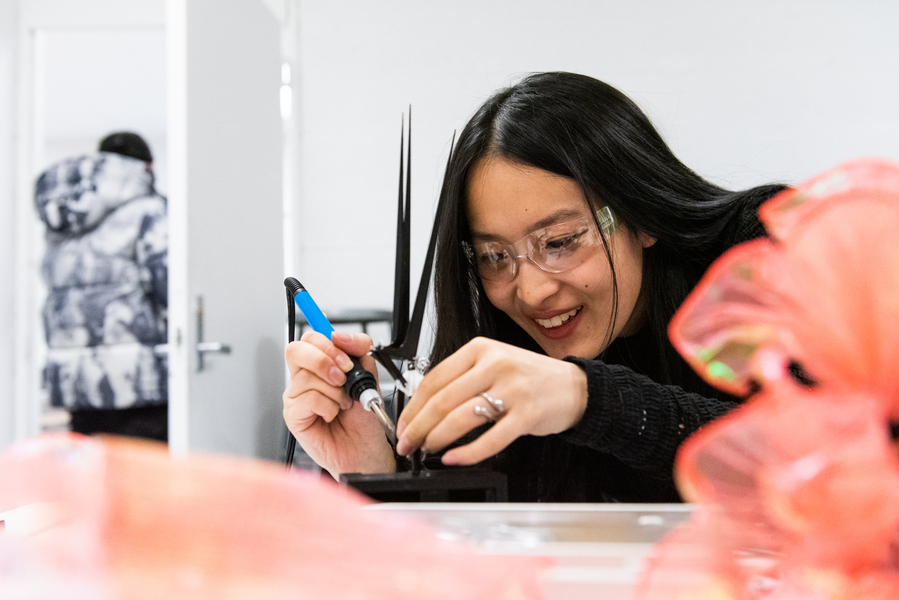
Shua Cho works on her artwork in “Introduction to Physical Computing for Artists” at the MIT Student Art Association. Photo: Sarah Bastille
By Ken Shulman | Arts at MIT
One student confesses that motors have always freaked them out. Amy Huynh, a first-year student in the MIT Technology and Policy Program, says “I just didn’t respond to the way electrical engineering and coding is usually taught.”
Huynh and her fellow students found a different way to master coding and circuits during the Independent Activities Period course Introduction to Physical Computing for Artists — a class created by Student Art Association (SAA) instructor Timothy Lee and offered for the first time last January. During the four-week course, students learned to use circuits, wiring, motors, sensors, and displays by developing their own kinetic artworks.
“It’s a different approach to learning about art, and about circuits,” says Lee, who joined the SAA instructional staff last June after completing his MFA at Goldsmiths, University of London. “Some classes can push the technology too quickly. Here we try to take away the obstacles to learning, to create a collaborative environment, and to frame the technology in the broader concept of making an artwork. For many students, it’s a very effective way to learn.”
Lee graduated from Wesleyan University with three concurrent majors in neuroscience, biology, and studio art. “I didn’t have a lot of free time,” says Lee, who originally intended to attend medical school before deciding to follow his passion for making art. “But I benefited from studying both science and art. Just as I almost always benefited from learning from my peers. I draw on both of those experiences in designing and teaching this class.”
On this January evening, the third of four scheduled classes, Lee leads his students through an exercise to create an MVP — a minimum viable product of their art project. The MVP, he explains, serves as an artist’s proof of concept. “This is the smallest single unit that can demonstrate that your project is doable,” he says. “That you have the bare-minimum functioning hardware and software that shows your project can be scalable to your vision. Our work here is different from pure robotics or pure electronics. Here, the technology and the coding don’t need to be perfect. They need to support your aesthetic and conceptual goals. And here, these things can also be fun.”
Lee distributes various electronic items to the students according to their specific needs — wires, soldering irons, resistors, servo motors, and Arduino components. The students have already acquired a working knowledge of coding and the Arduino language in the first two class sessions. Sophomore Shua Cho is designing an evening gown bedecked with flowers that will open and close continuously. Her MVP is a cluster of three blossoms, mounted on a single post that, when raised and lowered, opens and closes the sewn blossoms. She asks Lee for help in attaching a servo motor — an electronic motor that alternates between 0, 90, and 180 degrees — to the post. Two other students, working on similar problems, immediately pull their chairs beside Cho and Lee to join the discussion.
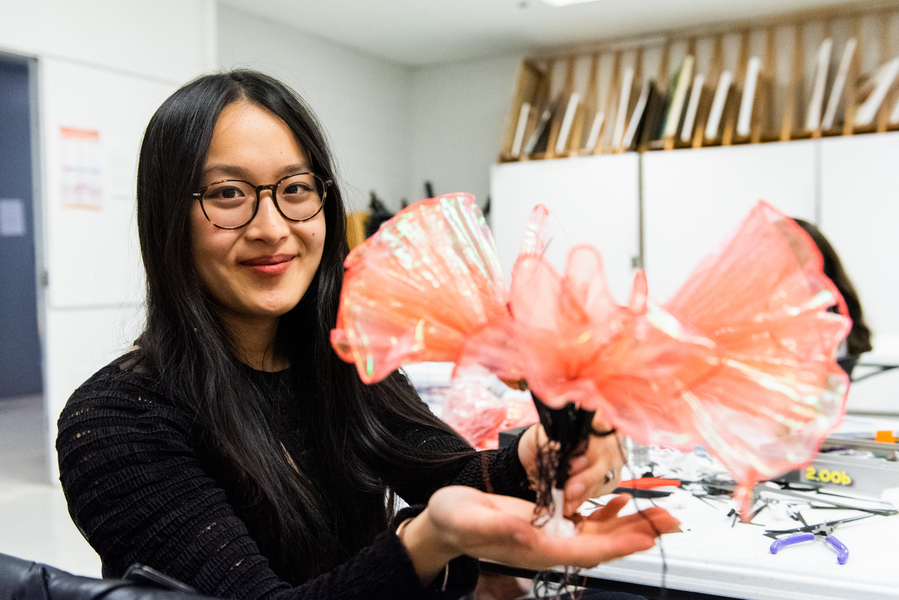
Shua Cho is designing an evening gown bedecked with flowers that will open and close continuously. Her minimum viable product is a cluster of three blossoms, mounted on a single post that, when raised and lowered, opens and closes the sewn blossoms. Photo: Sarah Bastille
The instructor suggests they observe the dynamics of an old-fashioned train locomotive wheel. One student calls up the image on their laptop. Then, as a group, they reach a solution for Cho — an assembly of wire and glue that will attach the servo engine to the central post, opening and closing the blossoms. It’s improvised, even inelegant. But it works, and proves that the project for the blossom-covered kinetic dress is viable.
“This is one of the things I love about MIT,” says aeronautical and astronautical engineering senior Hannah Munguia. Her project is a pair of hands that, when triggered by a motion sensor, will applaud when anyone walks by. “People raise their hand when they don’t understand something. And other people come to help. The students here trust each other, and are willing to collaborate.”
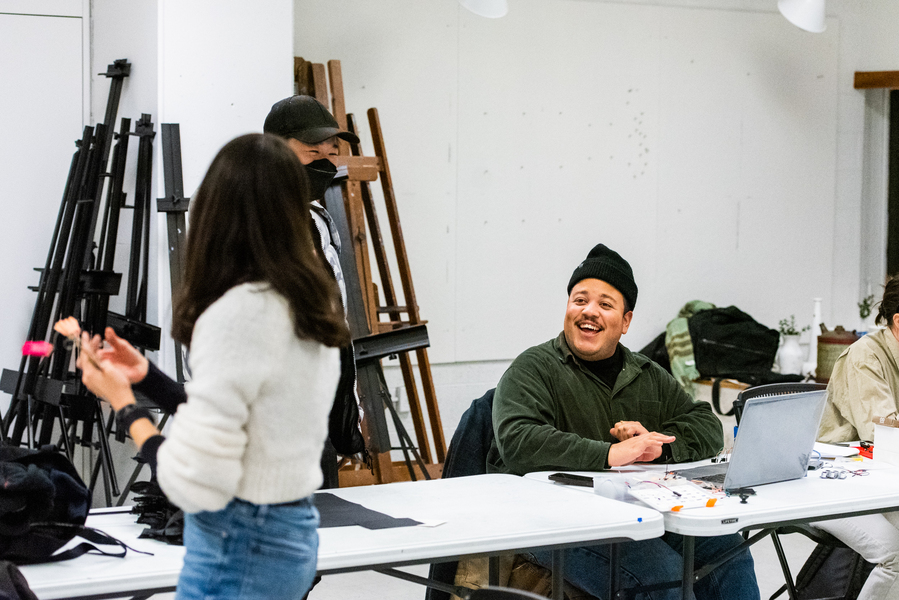
Student Hannah Munguia (left), instructor Timothy Lee (center), and student Bryan Medina work on artwork in “Introduction to Physical Computing for Artists” at the MIT Student Art Association. Photo: Sarah Bastille
Cho, who enjoys exploring the intersection between fashion and engineering, discovered Lee’s work on Instagram long before she decided to enroll at MIT. “And now I have the chance to study with him,” says Cho, who works at Infinite — MIT’s fashion magazine — and takes classes in both mechanical engineering and design. “I find that having a creative project like this one, with a goal in mind, is the best way for me to learn. I feel like it reinforces my neural pathways, and I know it helps me retain information. I find myself walking down the street or in my room, thinking about possible solutions for this gown. It never feels like work.”
For Lee, who studied computational art during his master’s program, his course is already a successful experiment. He’d like to offer a full-length version of “Introduction to Physical Computing for Artists” during the school year. With 10 sessions instead of four, he says, students would be able to complete their projects, instead of stopping at an MVP.
“Prior to coming to MIT, I’d only taught at art institutions,” says Lee. “Here, I needed to revise my focus, to redefine the value of art education for students who most likely were not going to pursue art as a profession. For me, the new definition was selecting a group of skills that are necessary in making this type of art, but that can also be applied to other areas and fields. Skills like sensitivity to materials, tactile dexterity, and abstract thinking. Why not learn these skills in an atmosphere that is experimental, visually based, sometimes a little uncomfortable. And why not learn that you don’t need to be an artist to make art. You just have to be excited about it.”
Robot Talk Episode 40 – Edward Timpson

Claire chatted to Edward Timpson from QinetiQ all about robots in the military, uncrewed vehicles, and cyber security.
Ed Timpson joined QinetiQ in 2020 after 11 years serving in the Royal Navy as a Weapons Engineering Officer (Submarines) across a number of ranks. Joining QinetiQ Target Systems as a Project Engineer and also managing the Hardware team, he had success in developing new capabilities for the Banshee family of UAS. He then moved into future systems within QinetiQ as a Principal Systems Engineer specialising in complex trials and experimentation of uncrewed vehicles. He now heads up the Robotics and Autonomous Systems capability within QinetiQ UK.